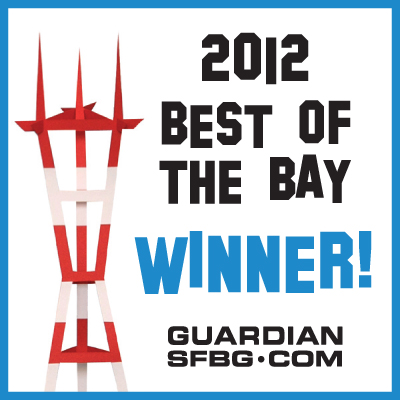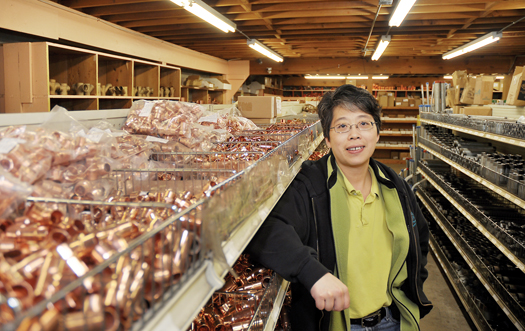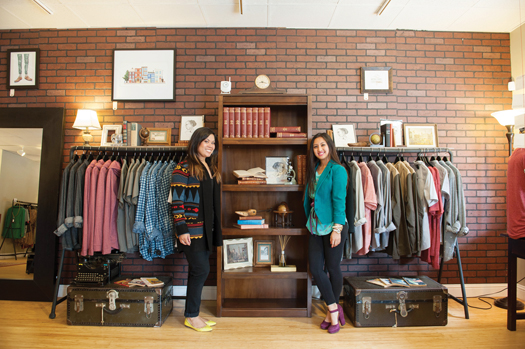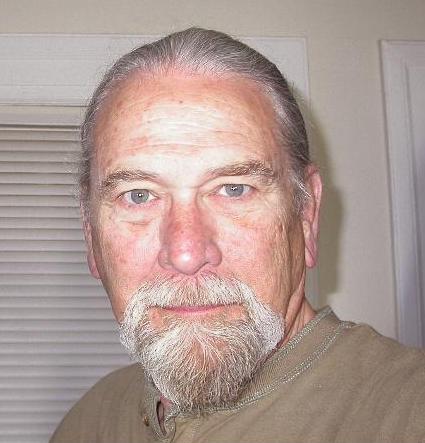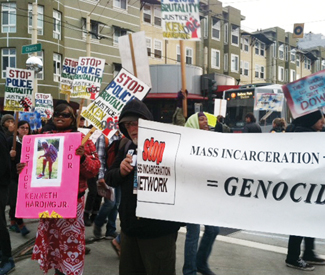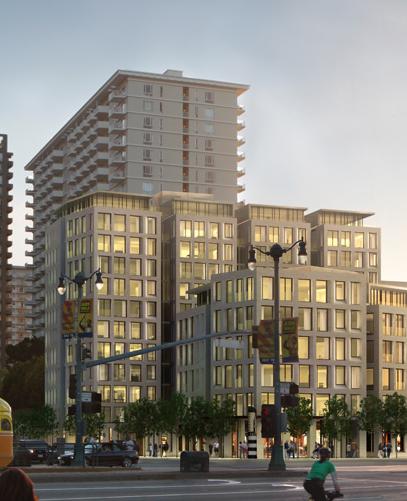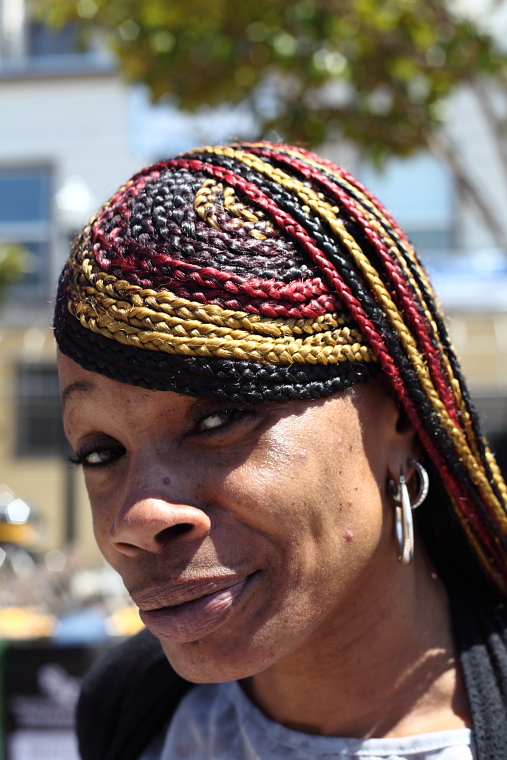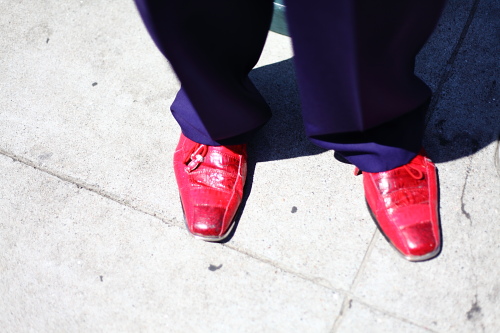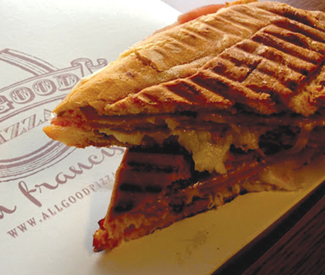Best of the Bay 2011 Editors Picks: Arts and Entertainment

Guardian photo by Brittany M. Powell
He’s the mustachioed maniac who wields a sewing machine and an endless array of heavy metal T-shirts, creating quilts depicting claw-bearing beasties, horned skulls, and other images that wouldn’t be out of place on an Iron Maiden stage backdrop. Ben Venom (née Baumgartner), whose MFA from the San Francisco Art Institute definitely didn’t include quilting, is self-taught when it comes to pieces like his massive quilt, “See You On the Other Side,” featured in Yerba Buena Center for the Arts’ prestigious Bay Area Now 6 exhibition. He also presented work in You Should Be Living, a display of metal-inspired pieces at the Wolverhampton Art Gallery in Birmingham, England (homeland of Black Sabbath, Led Zeppelin, Judas Priest, and Napalm Death). Venom has even whipped up a baby quilt for an infant who’ll grow up with a unique appreciation of Metallica and the Scorpions.
www.benvenom.com
“We’re giving tax breaks to companies that allow people to meet in a virtual space,” Erick Lyle told the Guardian prior to the opening night of Streetopia, a multidisciplinary, utopian community art festival that he, Kal Spelletich, and Chris Johanson curated. “But this event will really show the vibrancy that is right here.” In the battle to keep the second tech bubble from edging everyone else out of the city, Streetopia was proactive, asking its participants not for dire predictions, but to share images of what their utopian SF would look like. For more than a month, there were classes on civilian investigative reporting taught by working journalists, dance performances in the street, shared meals in the Tenderloin National Forest, art in empty storefronts, and much more — proof positive that a San Francisco which doesn’t require stock options of its inhabitants is still very much thinkable and alive.
www.streetopiasf.com
In the age of downloadable singles and quick-click clips, UnderCover Presents‘ series of one-whole-album-with-one-live-show pairings values the full record experience. The quarterly event is an inspired mashup comprised almost entirely of Bay Area-based musicians, with each band performing just one reinterpreted song off a classic album. Thus far, there have been shows at Coda (now Brick and Mortar Music Hall), Public Works, the Rickshaw Stop, and the Independent; full nights spent luxuriating in every crevice and groove of the Velvet Underground’s Velvet Underground and Nico, the Pixie’s Doolittle, Nick Drake’s Pink Moon, and Black Sabbath’s Paranoid. To complete the sparkling tribute experience, a pre-recorded album of all the covers is doled out at each performance, to be played in its entirety beyond those singular shows.
www.undercoverpresents.com
“A place beyond time, beyond space to experience movies, drinks, and cosmic reverberations.” We know this is Best of the Bay, but the Vortex Room is a contender for Best of the Galaxy. A website, a lounge, a retro-flavored rip in the space-time continuum? Yep, it is all of the above. Host with the most Scott Moffett draws from in-house Cosmic Hex Archive, which includes an online library of delicious, nearly-forgotten sleaze and genre gems (just a taste: 1976’s Soul Hustler, a.k.a. The Day the Lord Got Busted). Most films cost $3.95 to download, but are even cheaper if you become a member. For maximum magick, get thee to one of the Vortex Room’s cult-film double-features, which start up again, weekly, in August.
1082 Howard, SF. www.cosmichex.com

Photo courtesy of Bhangra Empire
You may not know this, but you are living in the shadows of an empire. An empire with an origin spanning three continents and stretching back to 2006. Its ruling class is composed of fierce athletes and dedicated artists who preserve a lively tradition with the concentration of tigers on the prowl — but who aren’t afraid to dress up in outrageous costumes and re-enact hilarious Bollywood movie sequences. Behold, Bhangra Empire, a dazzling entity of interlocking steps and poised limbs that performs contemporary variations on bhangra, the Punjabi harvest dance that was transformed in underground clubs in 1980s London into a vital global art form. The Bay Area, with its huge Indian population and many fans of all things subcontinental, has embraced bhangra wholeheartedly, and the Bhangra Empire troupe — our hometown representative at national bhangra dance competitions (and even at the White House) — helps keeps us all on our toes.
www.bhangraempire.com
Ladies in the music biz deserve to be heard — weirdly, that still needs to be reiterated in 2012 — and Women’s Audio Mission is helping them get loud. The nonprofit is staunchly dedicated to “the advancement of women in music production and the recording arts.” As it notes, this is a field where women are chronically under-represented. WAM hires teachers for recording classes and has its own in-house studio, which means affordable recording time for budding female artists. Last year, the truly exciting local all-girl teenage rock ‘n’ roll band the She’s recorded their debut album at WAM, and this year the band is gaining some serious traction with radio spots. Ever grateful, the quartet behind the She’s credits WAM with realizing their dream (aww). Other clients include Kronos Quartet, Making Dinner, and Brazil’s Constantina. Here’s to a female future of recorded sound.
1890 Bryant, Suite 312, SF. (415) 558-9200. www.womensaudiomission.org

Photo by Gariel Hurley
After a wild first couple of years, Oakland’s premiere way-amateur wrestling night, Hoodslam, is still flexing its muscles once a month — these days at the Oakland Metro Operahouse. Full of soap opera-worthy subplots, grudge matches, awesome costumes, awesome-er characters, a noisy metal house band, burlesque interludes, giant plushy referees, and oh, even some wrestling, Hoodslam’s signature mayhem makes us downright giddy on so many levels. Whether we’re watching a pair of zombie fighters body-slam each other into the ropes, a bondage gear-wearing gimp get tossed over them, a mafia mob throw fedoras into the ring, or a squadron of burly stoners mop it up with whoever their hapless opponents of the moment might be, we’re right there with them, climbing the ladder, and getting higher. Fuck the fans!
Oakland Metro Operahouse, 630 Third St., Oakl. (510) 763-1146, www.birdswillfall.com
It is no small feat to write about suburban kids loving hip-hop without coming across as condescending or a-historic, but somehow a free-styling Minnesota-bred woman managed it. San Francisco-based author Laura Goode triumphed with Sister Mischief (Candlewick, $16.99, 367pp), a young adult novel about a gang of outsider girl friends who take on the powers of conformity at their whitebread, fundamentalist-controlled high school by forming a queer-straight hip-hop alliance (and performing their feminist lyrics for unwitting audiences). The book is hardly preachy, but does include teenage conversations about race, cultural co-optation, and sexuality — along with a scene that pretty well teaches you how to smoke weed — and is flush with curiosity, radicalism, and outright guffaws.
www.lauragoode.com
Graphic journalism isn’t really new, though given the reluctance some people have in acknowledging its legitimacy, you’d be forgiven for thinking it’s a more fringe concept than it actually is. Bay Areans are blessed with a wealth of these non-traditional journos, who document everything from a day in the life of a Mission District bartender to the gritty realities of an afternoon on Sixth Street. Susie Cagle‘s in-depth coverage of Occupy, for instance, has kept our eyeballs glued to our computer screens and Twitter feeds pretty much since the movement’s inception. Sharp, savvy, unsentimental, and blessed with an expressive pen and a keen ear, Cagle illustrates her eyewitness accounts of encampments, raids, building occupations, marches, and more with images that cut straight to the human core of the stories she gathers.
www.thisiswhatconcernsme.com
Culminating in a grand reopening in 2009 after 43 years of dereliction, the revitalization of Fox Theatre should serve as a model for all of the Bay Area’s beautiful rundown old movie houses. As befitting a building owned by the City of Oakland and listed on the National Registry of Historic Places, the $73 million renovation was done with an eye for detail. Myriad are the Fox’s charms: its grand old marquee; its cross-legged statues flanking the stage, regarding the audience with glowing green eyes; the ornately-molded ceiling, mosaic walls, and exceptional acoustics. The A-list talent on stage can’t help but notice the grandeur of its surroundings, and awestruck shout-outs to the theater between songs, in front of 2,800 rapt audience members, are common. Whoever’s headlining is almost beside the point when one is surrounded by such architectural beauty.
1807 Telegraph, Oakl. (510) 302-2250, www.thefoxoakland.com
We’ve heard the phrase “chefs are the new rock stars” enough to make us (s)cream. Turntable Kitchen both embodies this sentiment and finely chops it to pieces. Husband and wife duo Kasey and Matthew put together the website, with occasional help from a drop-by musician or chef. A typical visitor might stop by the Turntable Kitchen to hear “three belly-burning covers of the Clash’s ‘Guns of Brixton'” in the Served Three Ways feature, or to get the ingredients for the perfect asparagus frittata in the recipe index — musically paired to Field Music, thanks to the dishes’ festive and delicate notes. Or maybe they’ll sign up for the popular Pairings Box, which arrives each month with recipes, dry ingredients, and a limited-edition vinyl seven-inch single meant to match the mood of the meal inside.
www.turntablekitchen.com
On an otherwise nondescript block in SOMA, there is a door painted come-hither red. Don’t be shy, grab that knob! Inside you’ll find God knows what: dance, theater, performance art — it’s something different almost every night. And as bonus, if you come away confused or disgusted from this churning artists’ incubator, you’re only out a few bucks. The Garage has been around since Joe Landini opened shop in a storefront around the corner from his current location. Landini’s mission was to create a safe house for artists, a place to try anything. It has made the venue, with its programming, residencies, and workshop performances, appealing to local art-makers and adventurous audiences alike.
715 Bryant, SF. (415) 518-1517, www.975howard.com
Recent SFSU Theatre Arts grad Megan Trout might be relatively new to the Bay theater scene, but we’ve had our eyes on this rising young star since she burst out with the 11th Hour Ensemble’s first devised-theater piece Alice in 2010. Fearless, versatile, and dynamic, endowed with crack comic timing and equally enviable dramatic chops, Trout has swum in the weird and wonderful waters of the Aurora Theatre’s Metamorphosis, Symmetry Theatre Company’s Patience Worth, Megan Cohen’s A Three Little Dumplings Adventure parts one and two, Boxcar Theatre’s Buried Child, and A Lie of the Mind (to name but a few), while continuing to create new intensely physical theater works with the 11th Hour Ensemble, of which she is a co-founder. We honestly have no idea what play or theater space she’ll turn up in next — but we’re definitely looking forward to it. You should be too.

Photo courtesy of Mariachi Femenil Orgullo Mexicano
Those of you who are familiar with such things will know one rarely sees a female mariachi musician. Rarely, but not never: introducing Mariachi Feminil Orgullo Mexicano. The 10-person troupe boasts full string, brass, and rhythm sections, and every member is a woman. Feminine force like this — wrapped in electric blue, floor-length skirted uniforms edged in stunning silver trim — isn’t something you see every day at your favorite restaurante. Established in 2007, the education-minded troupe was the first XX-chromosomed group of its kind in the Bay Area. Since then, it’s been winning over audiences with its plaintive, powerful renditions of Mexican classics and new favorites.
www.mariarchifom.com
Car chases don’t get much better than the scenes of Steve McQueen speeding through San Francisco in Bullitt (1968). Given the driving, heart-pounding beat and casual-cool flow of San Jose rapper Antwon’s “Helicopter” music video — the track’s off the Fantasy Beds mixtape — it made perfect cinematic sense for director Brandon Tauszik to match the song with quick vintage clips of the classic flick. The resulting three-minute video dips between those intense McQueen thousand-yard stares as cars lunge over notoriously steep hills in a washed out Technicolor haze, spliced with modern next-big-thing Bay Area hip-hop producers (Antwon, MondreMAN, and Squadda B of Main Attrakionz) and their undeniably attractive pals, wandering their neighborhoods, chilling on porches, and pouring spicy Sriracha over hearty breakfasts. “Fuck ’em all/that’s my new motto” Antwon raps as the beat steadies and scenes flash by — a thrilling compliment to the classic footage, given the film’s original jazz score.
www.brandontauszik.com
Shop, record label, small concert purveyor — Oakland’s 1-2-3-4 Go! Records is a multi-use punk haven, selling rare and highly desirable underground vinyl, releasing albums by noisy locals, and hosting roaming growlers in an intimate setting. Like its down-south contemporary, indie-music haven Burger Records, 1-2-3-4 Go! harks back to the days of dusty record shops acting as all-purpose hangouts, and doing it well. The site has hosted all-ages shows by Australia’s Royal Headache, Audacity (a Burger Records favorite), and locals Uzi Rash, Apache, and Street Eaters. The label has released vinyl by East Bay garage messiahs Shannon & the Clams, King Lollipop, and the Sandwitches, among others. And the cozy store has welcomed scads of eager rock ‘n’ roll fans from throughout the Bay, with open denim jacket-clad arms.
423 40th St., Oakl. (510) 985-0325, www.1234gorecords.com
A long time ago (actually every Sunday, noon-3pm) in a galaxy far, far away (in fact, Studio Gracia in SoMa) … there came a troupe of heroes to teach and uphold a masterful tradition of movement, grace, control, and oneness with a universal force. No, not yoga — think Yoda, and picture Force with a capital F. Then envision a choreography class filled with lightsaber-wielding Jedi aspirants eager to keep the Star Wars legacy alive IRL. Not that there’s any danger of that boundless franchise running out of nerd fuel, but the Golden Gate Knights, organized by Alain Bloch, certainly have a stellar thing going. Who wouldn’t want to learn the “fancy flourishes and spins, including forward and reverse spins, inverted grips, and figure eights” of lightsaber brandishment in an atmosphere so respectful of its Jedi legacy that each class begins with five minutes of meditation? You get a little exercise out of it, too — in no time, it’ll bye-bye Jabba, hello Leia.
www.goldengateknights.com
Really though, Disposable Film Festival is a misnomer. Founded in 2007, with an inaugural event at Artists’ Television Access in early 2008, DFF has since evolved into a traveling-fest juggernaut with screenings in Paris, Beijing, Brazil, Macedonia, Argentina — basically, anywhere with open-minded audiences hungering for unique short films. Here’s where the “disposable” part comes in: the films are made DIY-style, using technology of the hand-held, pocket-sized, and easily-accessible-to-everyone variety, like cell phones and webcams. And though its festival screenings are a global phenomenon, DFF also hosts workshops, panel discussions, and other events (bike-in movies!) aimed at inspiring artists — especially young folks who are just discovering the wide world of creative filmmaking beyond those 3D superheroes at the multiplex.
www.disposablefilmfest.com
Once every year, right around Pride time in June, a fantastical fey Imaginarium of uninhibited queer art, dance, theater, ecology, lube-wrestling, puppy piles, porn debuts, and fearlessly naked fabulosity pops up in the old Tower Records building in the Castro. This is the fag-ulous Faetopia festival which, for one delirious week, complements the corporate-sponsored and slickly marketed Pride happenings with a burst of summer solstice fairy dust. The event comes courtesy of the Radical Faeries, those scruffy pan-sexual Pagan sprites whose naturist movement has a long history in the Bay Area, where they spread their gay-gay wings from untamed redwood groves to notorious Burning Man camps. More than 50 artists join forces to create programs — like Gay Hist-Orgy (performer Ian McKinnon’s “cruise of gay historical figures”) and Flaming Queens on Fire! (fire-dancing lessons) — that stuff some good ol’ polymorphous perversity into Pride’s polished corners. And at the very center? Faetopia’s there too, with the hippie-chill Fairy Freedom Village area within the Civic Center festival itself.
www.faetopia.com
In response to the onslaught of mass-produced, sugar-rush electronic sounds ruling the pop charts these days, many finer San Francisco dance floors have returned to a more underground aesthetic. This renaissance of sophisticated techno plugs into a global movement — unabashedly intelligent, yet still madly danceable. And while many fantastic local party promoters have emerged, the As You Like It crew has been on a massive tear like no other. In just two years, they have risen from a nomadic underground existence to pack larger legal venues with dozens of parties that feature uncompromising local and international talent, yet never lose that singular, slightly extra-legal vibe and attention to detail. Some of the most exciting names in dance music have passed through the Bay Area thanks to As You Like It’s dedication, helping to make our party scene an essential destination for dance fanatics. To fittingly repurpose one of the crew’s favorite adjectives: quality.
www.ayli-sf.com

Photo by Anastacia Powers
Voguing — that drop-dead fabulous and seriously competitive gay African American dance-battle art form — has recently come back into the spotlight, with a new generation of club kids and art queens taking to the floor to chop, mop, drop, drag, gag, and get “cunty.” San Francisco, of course, has put its own spin on the high-attitude, limb-flinging style that originated in the ’70s in underground ballrooms on the East Coast, transforming the dance into a way to get in shape. You may not have come from the streets, but you’re going to leave Vogue and Tone with amazing thighs, honey. The wiggy workout class — Tuesdays, 7-8:30pm, at Dance Mission Theater and Thursdays, 8:30-9:45pm, at ODC Commons — is led by kicky, spinny showman Sir JoQ, a.k.a. Jocquese Whitfield. The dance has also hit the club circuit, leaping on a recent trend of retro-style dance-floor workout sessions, so be on the lookout and don’t throw shade. If all you know of vogue is that old Madonna track, it’s time to get in-shape and up-to-date.
www.dancemission.com
City Notes: San Francisco will never counsel you to try the chowder bowl at Fisherman’s Wharf. Nor will it prove useful in finding the best way to walk between Chinatown and the Ferry Building. It won’t give you directions at all, for that matter. The artful wood-bound guidebook, put together by a team of Wesleyan alumni headed by Jesse Coburn, is comprised of quiet shots and histories behind 25 little-known sites in San Francisco, such as the Columbarium, Molinari-Mana Park, Mount Davidson, and the Swedenborgian Church. City Notes doesn’t spill the address beans, making it the perfect treasure hunt for the urban explorer-wanderer. The book’s covers are hand-bound to the velvety sheets within; its producers had so much fun making the finely crafted object, in fact, that they plan on putting together similar guides for other cities around the world.
www.terrywarnerpress.com
How does Stagewerx proprietress Ty McKenzie do it? She always finds the way to a “yes” where others might jump to a “no.” In both its old location on Sutter Street and its brand-new digs on Valencia, Stagewerx has created a supportive environment par excellence for performers of every discipline, amateurs and seasoned pros alike. From ongoing performance series such as Solo Sundays and Previously Secret Information to the raucous hi-jinks of Picklewater Clown Cabaret and Circus Finelli; from Tom Sway’s low-key, lo-fi music series Underground Sound to ambitious runs of new works by companies such as PianoFight, Wily West Productions, and Foul Play, Stagewerx’s focus on helping quirky and emerging artists find a “yes” of their own is more than refreshing — it’s essential.
446 Valencia, SF. www.stagewerx.org
For all the underworld grittiness ascribed to the storied block of Sixth Street between Market and Mission, you’d think the guttural yowl of punk — or at least the soothing howl of good ol’ rock and roll — would be an integral part of the roiling Sixth mix. And yet, can you believe it, there was nary a hole-in-the-wall live rock club there (or anywhere else in the mid-Market or downtown area for that matter) until RKRL, our very own CBGB, opened last year. The result of a collaboration between Club Six and the wild LowSF crew, RKRL has already hosted an onslaught of local and extra-local rabble-rousers, including the Devil’s Own, Ruleta Rusa, the Mutilators, and Animal Games. Are we back in a world where down-and-dirty downtown rock clubs still exist? Hell yes.
52 Sixth St., SF. (415) 658-5506, www.facebook.com/RKRLSF
Since 1989, when the troupe was founded by community leader Carlos Aceituno, Fogo Na Roupa has been taking to the streets, the stages, and the dance studios with its rhythmic, Latin-African-hip-hop fusion beats. Where might you have seen them perform? Perhaps during its be-feathered, be-dazzled promenades through SF Carnival — with as many as 200 performers in a single appearance, the group is hard to miss. If you’re feeling the fogolystics — the term the troupe has coined to describe its powerful mix of musical genres — you can add your sparkle to the mix. On Tuesdays and Saturdays they hold an open practice at Mission Cultural Center that you can jump in for just $10. Seriously, everyone is invited — the group prides itself on performers ranging from kids to senior citizens.
(510) 286-7926, www.gofogo.com
Basic bar moves and halting hip-hop steps may be what stuck with you from the dance classes of your youth, but (thankfully) today there’s a new kind of movement program that’s all about teaching confidence and power, in addition to how to rule a dancefloor. We’re talking about Grrrl Brigade. Dance Mission Theatre hosts this series of classes in hip-hop, jazz, modern, and taiko (that’s Japanese drum dancing) for nine to 18-year-old females. As they rock the courses, their leadership develops along with their dance skills. Grrrl Brigade students roar with self-esteem, thrive on collaboration, and have been known to pound away on gigantic drums, taking the stage each year in a young person’s version of The Nutcracker, and in a springtime show focusing on real-life issues the performers deal with when they’re not in the spotlight.
Dance Mission Theater, 3316 Mission, SF. www.dancemission.com

Guardian photo by Brittany M. Powell
Some may have seen the deserted stretch of Harrison Street as a business liability, but Jay Beaman and Oliver Piazza of Thieves Tavern and Dirty Thieves didn’t let the low walk-up potential dissuade them from opening Dear Mom. We’re glad. Because if they had, we’d be bereft of their expansive boozery (once the salsa club El Rincon) flush with affordable booze, a photobooth, beckoning seating areas, and a kitchen that hosts pop-up eateries hawking sushi, fried green tomato hamburgers, and everything in between. The one thing Mom needs to be an SF standard is cheapo local icon Broke Ass Stuart hawking picklebacks (whiskey shots with pickle juice chaser, duh) on Wednesday nights in his never-ending quest to pay rent. Oh wait, that actually happens.
2700 16th St., SF. (415) 625-3362

Guardian photo by Brittany M. Powell
From the outside, it’s an unassuming Mission District storefront, infrequently open to the public. But inside, Area 2881 reveals a rare glimpse into the private lives of robots. Perched on miniature foot-lit pedestals, two robot slaves dance for roving audiences, their slightly jerky motions belying the complexity of their 41 meticulously designed joints. The slaves appear both vulnerable yet indestructible, humanoid yet alien, and the weird spectacle of their forced entertaining is both unsettling and strangely affecting. The rest of the room is a whirring, spinning, buzzing paroxysm of light and kinetic sculpture, ushered into this world from a parallel plane by the human hands of mild-mannered applications engineer by day, mad scientist by night, Carl Pisaturo.
2881 23rd St., SF. www.carlpisaturo.com
Afterhours museum parties full of bright young things witnessing cool artistic happenings are anything but a rarity in our forward-thinking area. And really, we wouldn’t have it any other way. May we especially highlight the amazing series that is L@TE: Friday Nights at BAM/PFA? This is — probably — the only such affair at which an “electric orchestra of pickle jars accompanied by abstract lighting machines” and the occasional pop-in by Devendra Banhart are a given. The wonderfully heady and innovative social gatherings fill the Berkeley Art Museum with experiential art and music (construct rainbow prisms, listen to Negativland, deconstruct Scritti Politti records, join an avant-cabaret) and light up the Pacific Film Archives with glorious 16mm and 35mm prints of rare and recently restored films. Also: dancing! If you’ve ever dreamt of meeting a soul mate while watching 3-D animation, participating in interactive dance performances, and peeping the latest emerging local artists, you need to get L@TE.
Occasional Fridays, 5:30-9pm, $7. Berkeley Art Museum, 2626 Bancroft Way, Berk. (510) 642-0808, www.bampfa.berkeley.edu
Whether it’s the free yoga classes, creative summer art camp, or Saturday afternoon alfresco concerts, the Bayview Opera House‘s offerings are as vibrant and active as they were when the building was built in 1888 (maybe more so? The Guardian wasn’t around back then). The historic landmark community center supports the still-diverse neighborhood of Bayview-Hunters Point, hosting awesome fundraisers like Black Men Can Cook and Mendell Plaza Presents, a 12-week concert series that transforms a little triangle of pavement into a full-on dance floor featuring local neighborhood musicians — not to mention domino tables and BBQ — alongside a community garden filled with vibrant veggies. Kids from the 100% College Prep Club make up much of the musical talent. Here’s to 125 more amazing years.
4705 Third St., SF. (415) 824-0386, www.bvoh.org

